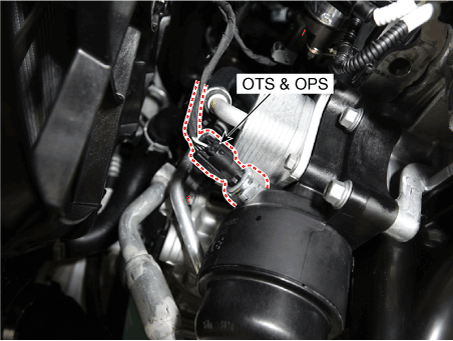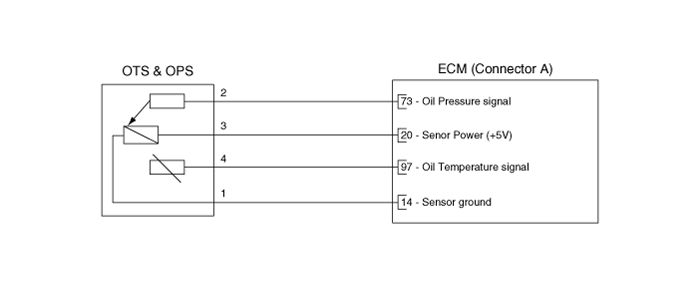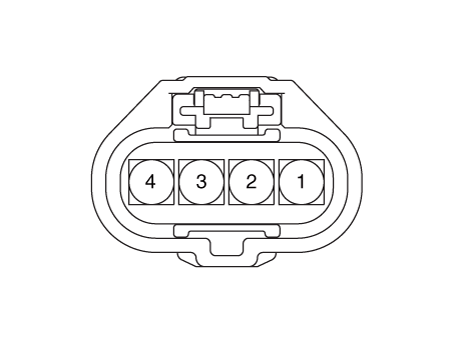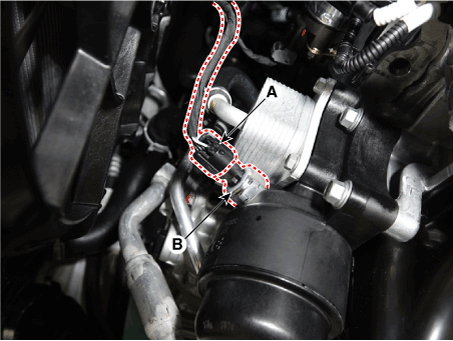Hyundai Elantra: Engine Control System / CVVT Oil Temperature Sensor (OTS)
Hyundai Elantra (CN7) 2021-2025 Service Manual / Engine Control / Fuel System / Engine Control System / CVVT Oil Temperature Sensor (OTS)
Description and operation
| Description |
Continuous Variable Valve Timing (CVVT) system advances or retards the valve timing of the intake and exhaust valve in accordance with the ECM control signal which is calculated by the engine speed and load.
By controlling CVVT, the valve over-lap or under-lap occurs, which makes better fuel economy and reduces exhaust gases (NOx, HC) and improves engine performance through reduction of pumping loss, internal EGR effect, improvement of combustion stability, improvement of volumetric efficiency, and increase of expansion work.
This system consist of the CVVT Oil Control Valve (OCV) which supplies the engine oil to the cam phaser or cuts the engine oil from the cam phaser in accordance with the ECM PWM (Pulse With Modulation) control signal, the CVVT Oil Temperature Sensor (OTS) which measures the engine oil temperature, and the Cam Phaser which varies the cam phase by using the hydraulic force of the engine oil.
The engine oil getting out of the CVVT oil control valve varies the cam phase in the direction (Intake Advance/Exhaust Retard) or opposite direction (Intake Retard/Exhaust Advance) of the engine rotation by rotating the rotor connected with the camshaft inside the cam phaser.

Specifications
| Specification |
|
Temperature [°C (°F)]
|
Resistance (kΩ)
|
| -40 (-40) | 125.53 - 136.70 |
| -20 (-4) | 63.89 - 71.23 |
| 0 (32) | 26.83 - 30.07 |
| 20 (68) | 11.13 - 12.48 |
| 40 (104) | 4.89 - 5.50 |
| 60 (140) | 2.32 - 2.61 |
| 80 (176) | 1.17 - 1.32 |
| 100 (212) | 0.63 - 0.71 |
| 120 (248) | 0.37 - 0.41 |
| 140 (284) | 0.22 - 0.25 |
| 160 (320) | 0.14 - 0.16 |
Schematic diagrams
| Circuit Diagram |

Harness Connector

Repair procedures
| Inspection |
| 1. | Turn ignition switch OFF. |
| 2. | Remove the oil pressure & oil temperature sensor. (Refer to - "Removal") |
| 3. | After immersing the thermistor of the sensor into engine coolant, measure resistance between the OTS terminals 1 and 4. |
| 4. | Check that the resistance is within the specification.
|
| Removal |
| 1. | Turn the ignition switch OFF and disconnect the battery negative (-) cable. |
| 2. | Lift the vehicle. |
| 3. | Remove the engine room under cover. (Refer to Engine Mechanical System - "Engine Room Under Cover") |
| 4. | Disconnect the oil pressure & oil temperature sensor connector (A), and then remove the oil pressure & oil temperature sensor (B).
|
| Installation |
|
| 1. | Install in the reverse order of removal. |
 Accelerator Position Sensor (APS)
Accelerator Position Sensor (APS)
Description and operation
DescriptionAccelerator Position Sensor (APS) is installed on the accelerator pedal module and detects the rotation angle of the accelerator pedal...
 Oil Pressure Sensor (OPS)
Oil Pressure Sensor (OPS)
Description and operation
DescriptionIt generates the oil pressure and temperature information (output voltage) to control the pump operation proportional control valve in variable oil pump system...
Other information:
Hyundai Elantra (CN7) 2021-2025 Owner's Manual: Wheel Replacement. Tire Traction. Tire Maintenance
Wheel Replacement When replacing the metal wheels for any reason, make sure the new wheels are equivalent to the original factory units in diameter, rim width and offset. Tire Traction Tire traction can be reduced if you drive on worn tires, tires that are improperly inflated or on slippery road surfaces...
Hyundai Elantra (CN7) 2021-2025 Service Manual: Shift Lever
Components and components location Components1. Shift lever knob & boots assembly2. Shift lever assembly3. Shift cable4. Manual control lever5. Shift cable retainer Repair procedures Removal1.Turn OFF ignition switch and then diconnect the battery negative (-) cable...
Copyright © 2025 www.helantra7.com


